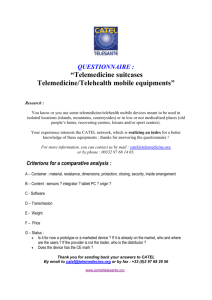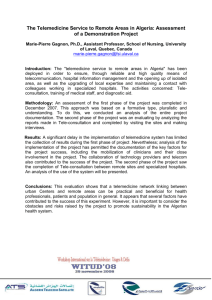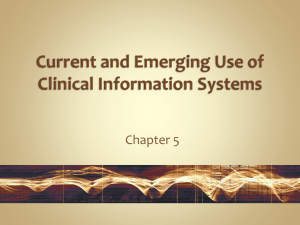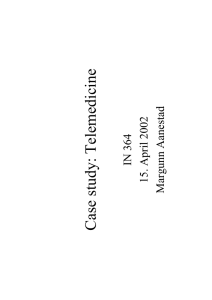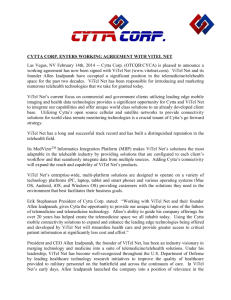I T U D
advertisement
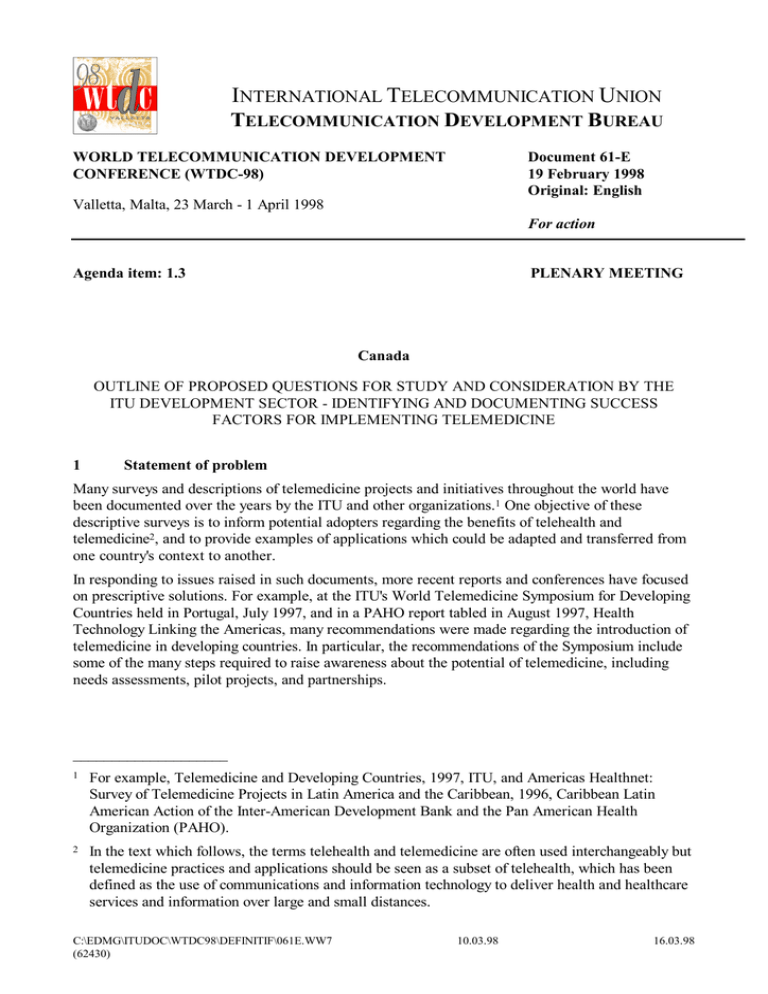
I NTERNATIONAL TELECOMMUNICATION UNION TELECOMMUNICATION DEVELOPMENT BUREAU Document 61-E 19 February 1998 Original: English WORLD TELECOMMUNICATION DEVELOPMENT CONFERENCE (WTDC-98) Valletta, Malta, 23 March - 1 April 1998 For action Agenda item: 1.3 PLENARY MEETING Canada OUTLINE OF PROPOSED QUESTIONS FOR STUDY AND CONSIDERATION BY THE ITU DEVELOPMENT SECTOR - IDENTIFYING AND DOCUMENTING SUCCESS FACTORS FOR IMPLEMENTING TELEMEDICINE 1 Statement of problem Many surveys and descriptions of telemedicine projects and initiatives throughout the world have been documented over the years by the ITU and other organizations.1 One objective of these descriptive surveys is to inform potential adopters regarding the benefits of telehealth and telemedicine2, and to provide examples of applications which could be adapted and transferred from one country's context to another. In responding to issues raised in such documents, more recent reports and conferences have focused on prescriptive solutions. For example, at the ITU's World Telemedicine Symposium for Developing Countries held in Portugal, July 1997, and in a PAHO report tabled in August 1997, Health Technology Linking the Americas, many recommendations were made regarding the introduction of telemedicine in developing countries. In particular, the recommendations of the Symposium include some of the many steps required to raise awareness about the potential of telemedicine, including needs assessments, pilot projects, and partnerships. ____________________ 1 For example, Telemedicine and Developing Countries, 1997, ITU, and Americas Healthnet: Survey of Telemedicine Projects in Latin America and the Caribbean, 1996, Caribbean Latin American Action of the Inter-American Development Bank and the Pan American Health Organization (PAHO). 2 In the text which follows, the terms telehealth and telemedicine are often used interchangeably but telemedicine practices and applications should be seen as a subset of telehealth, which has been defined as the use of communications and information technology to deliver health and healthcare services and information over large and small distances. C:\EDMG\ITUDOC\WTDC98\DEFINITIF\061E.WW7 (62430) 10.03.98 16.03.98 -2CMDT98/61-E While needs analyses are necessary, and pilot projects demonstrate what telemedicine technology can do, these have been insufficient by themselves to lead to adoption of long-term, appropriate telemedicine and telehealth solutions. Problems associated with adopting telehealth technologies are only partially solved by needs analyses and pilot or demonstration projects. The following list provides only some of the reasons for this: 1) Matching needs to appropriate solutions: while needs assessment techniques can identify needs, it is difficult to find the ideal match between identified needs and appropriate solutions. In order to help health care providers and users in developing countries to envision and adopt technological solutions which would adequately meet their specific health care needs, better feasibility models must be applied. Adopting countries need a chance to view, test, and experience potential solutions under a number of circumstances. 2) Financing: implementing systems following successful pilot projects requires financing. Capital loans and private sector partnering can bridge gaps temporarily, but these are inadequate as long-term solutions. Health care system funders must be able to realize savings from existing systems which can be used to pay for telehealth and telemedicine installations. 3) Change and new technology: technological implementation always brings about both foreseen and unforeseen (usually organizational) changes, positive and negative, which are difficult to forecast a priori. Pilot projects can create artificial expectations. 4) Awareness of context: there has been a pervasive tendency to treat telemedicine or telehealth as separate from the context of health care delivery. But telemedicine is but a communication and information tool which changes the way in which health care can be delivered, but not necessarily the central activity of health care delivery itself. Thus it should not be considered as separate from other health care delivery activities. It is not more important than training, health information, diagnosis, or therapy. 2 Question Proposal CAN/61/1 The 1997 ITU report on Telemedicine concluded that the ITU-BDT has a continuing role to play in raising awareness regarding telemedicine. It recommended that the ITU establish a database which could be updated annually and which would provide a source of information about pilot projects. Long-term telemedicine solutions which have been successfully adopted and sustained have managed to go beyond the stage of pilot studies and demonstrations. Different factors have contributed to these successes. These need to be documented and made available widely so that would-be adopters can learn from these best practices. What are these best practices in telemedicine and telehealth? It is suggested that criteria for best practices be developed, case studies collected and made widely available via the Internet and other means for both developing and developed countries who are considering adopting telehealth systems. Some steps which need to be followed: – Develop a questionnaire to identify criteria for success in telemedicine and telehealth, and distribute the questionnaire to experienced practitioners, administrators and researchers in telehealth, from various countries and professional disciplines. C:\EDMG\ITUDOC\WTDC98\DEFINITIF\061E.WW7 (62430) 10.03.98 16.03.98 -3CMDT98/61-E – Conduct literature searches. – Develop the list of criteria for success, based on the results of the above. – Select case studies to illustrate these successes. – Document the case studies and make them widely available. 3 Description of expected output A collection of success stories based on best practices in telemedicine and telehealth would be documented and made available electronically and by other media means (video is not excluded) to provide guidance to would-be adopters of telemedicine and telehealth. These success stories can be retrospective or contemporary case studies based on pre-identified criteria. The case studies would be made available to health care decision-makers from both developing and developed countries, to guide them in the selection and implementation of telehealth systems. The same case studies could also be used to develop benchmarks for future telehealth and telemedicine development, and could serve as guide posts for lending organizations. 4 Required timing of the expected output This is an on-going project which does not end with the documentation of a certain number of success studies. However, it would be expected that this project can be launched immediately in that a number of criteria can begin to be developed in discussions with different health care administrators, practitioners and researchers. This project is in keeping with the recommendations of the ITU's report on Telemedicine and hence, there is some urgency to keep the momentum of this report going. Thus it is proposed that the project be presented for formal approval on or before WTDC-98 in Malta. Following official launching, it should begin to provide the success stories on an accessible database within 12 months. 5 Proposers/Sponsors I originally submitted this proposal in my capacity of Director of Special Projects at Industry Canada, as Adjunct Professor at McGill University3, and as a member of the Interim Board of the newly formed Canadian Telehealth Association. However this does not mean that I have obtained the support of these organizations for this project. It would be important to seek the support of Health Canada and the World Health Organization in order to keep this project relevant. Accordingly, I have presented this suggestion as part of a report I am tabling with the WHO. ____________________ 3 The author of this document is still Adjunct Professor at McGill University. As of 2 January, 1998, she has departed from Industry Canada to become President of Infotelmed Communications Inc., a private consulting and training company devoted to demystifying telehealth technologies. C:\EDMG\ITUDOC\WTDC98\DEFINITIF\061E.WW7 (62430) 10.03.98 16.03.98 -4CMDT98/61-E 6 Sources of input required to carry out the study A questionnaire needs to be developed. This could be accomplished by Canadian researchers in the field of telemedicine, and then tested at both the G7 meeting described below, and WTDC-98 in Malta. Canada currently has the lead for the G7 global telemedicine project, which was officially launched last June in Kobe, Japan, at the 3rd International Telemedicine Conference. A first forum of G7 telemedicine representatives is expected to take place in Canada in March 1998. Potentially, input can be obtained from these representatives regarding the criteria for the success stories. There is also a need for a thorough literature search for the identification of success factors. This could be undertaken by a group of researchers in the field. Finally, the success stories need to be written, based on the identified criteria for success. Practitioners, researchers and administrators submitting the stories would be asked to write them up. It would then be necessary to format these for publication on the Internet. 7 1) Target audience Potential adopters as well as designers of telemedicine systems primarily in developing countries but also in regions where telemedicine is being considered as an alternative to current health care delivery patterns. 2) Telecom service providers, planners and policy-makers. 3) Management and engineering consultants. 4) Lending institutions and International Financial Institutions. 8 Proposed method of handling the question There is currently in Canada and around the world, a groundswell of interest and activity in telehealth and telemedicine. Thus it is proposed that this question be handled in the following manner, reflecting the need for the inputs described in item 6 above. This is only a suggested course of action. There may be other proposals which should be considered. – To identify the criteria for best practices, a restricted number of telemedicine and telehealth gurus need to be consulted via a questionnaire and distributed by fax or mail, with responses encouraged by use of an interactive web site, a computer-based discussion group, a listserv, a chat group or any other Internet supported means. – Once success criteria have been identified, they should be diffused widely amongst telemedicine circles along with a general call for submission of ideal examples, demonstrations, or success stories of projects or programmes. This could be advertised in telemedicine journals, through associations, through conferences, meetings and international events. – Best telehealth and telemedicine practices would then be documented, categorized, coded and published on an interactive web site and could also be the subject of a series of papers offered at a conference where some sort of award could be given, as an incentive. It would be important to obtain the collaboration of the ITU, the WHO, CIDA, Health Canada, the International Telemedicine Association and other similar organizations to make this project a reality. C:\EDMG\ITUDOC\WTDC98\DEFINITIF\061E.WW7 (62430) 10.03.98 16.03.98 -5CMDT98/61-E 9 Coordination It is important to coordinate this activity with the existing work of the IDRC, WHO, the G7 project coordinators in various countries and at Health Canada and Industry Canada and other international organizations. C:\EDMG\ITUDOC\WTDC98\DEFINITIF\061E.WW7 (62430) 10.03.98 16.03.98
